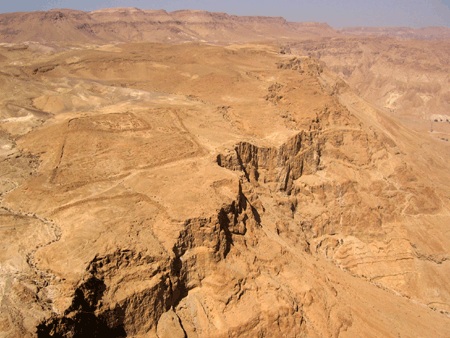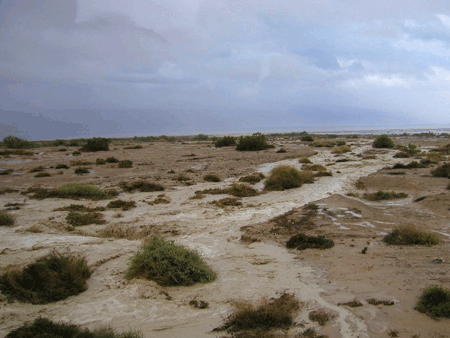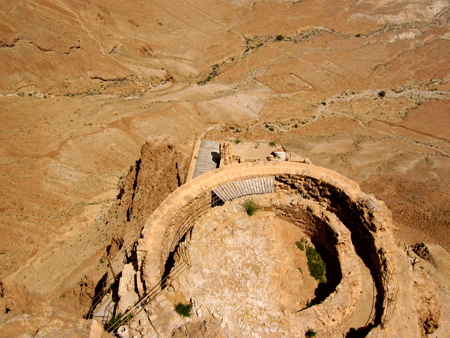|
|
|
 |
|
“FOR WATERS SHALL
BREAK FORTH IN THE WILDERNESS
AND STREAMS IN THE DESERT"
ISAIAH 35
|
|

- I just browsed your
website, and found it delightful. Your
groups must enjoy their time with you beyond
words. My question to you is, how did the
Jewish defenders enter Masada with their families?
I envision that there must have been a concealed
stairway, but I have not read that anywhere.
I know that they had elaborate cisterns to retain
water, but the rainfall in that area must be very
limited and on a mountaintop other water sources
seem unlikely. The Roman army had a
tremendous need for water as well. Any
comments of yours would be of great interest to
me.
Bud Chutter,
Virginia Beach, Virginia
|
Thanks Bud for the
very interesting questions about how the last Jewish
defenders and their families coped on Masada.
According to the account by first century A.D.
historian Josephus Flavius, facing off on the Masada
summit against the Roman army were 967 Judeans, men,
women and children. I assume that they climbed
Masada before the Roman siege would have made
ascent virtually impossible, even under the cover of
darkness.
As to how they reached the summit, here’s Josephus
description of Masada in The Jewish War, Book
VII, chapter VIII, iii, "A vast rock with a very
large perimeter and lofty from end to end [which is]
abruptly broken off on every side by deep canyons;
the precipices rise sheer from a bottom that is out
of sight, and from it rise cliffs on which no living
being can get a foothold except in two places where
the rock can be climbed with great difficulty."
Josephus continues by saying that one path leads
from the Dead Sea on the east; the other which is
easier, ascends from the west. The western,
"easier" approach was barred at its narrowest point
by a large tower which was impossible to bypass and
extremely difficult to capture. The eastern
path was called the "snake" path because of its
narrowness and constant winding course.
"Anyone walking along this route must firmly place
each foot alternatively. Destruction is an
obvious threat, for on either side, yawns an abyss
so terrifying as to daunt the boldest,” writes
Josephus.
Today when you visit Masada, you can climb the very
same snake path described by Josephus. On the
most treacherous points, however, steps have been
constructed. If you climb in the heat of summer at
noon, you may dehydrate but the hike is not at all
terrifying. On average, the climb takes about
forty-five minutes to an hour. My best time
was 29 minutes, but that was more than a decade ago!
There was a concealed staircase, in fact, but that
was an inner staircase, connecting the three levels
of the northern palace. Some of the original
winding staircase between the lower and middle
terraces is preserved intact to this very day.
After visiting the northern palace to admire the
stunning view and identify the Roman army camps
sprawled below, walk along the southwest perimeter
towards the synagogue and you'll find the steps
leading down to the lower level. You may not
recognize the original part of the staircase, for
it's so well preserved. It's always best to
bring a guide!
About the logistics of water, there are no springs,
even at the foot of Masada where the Romans camped.
The nearest springs are at Ein Gedi, about 15 miles
to the north. When the Romans finally
concentrated all energy on besieging Masada, it was
imperative that they defeat the zealots before the
onset of summer.
Herod the Great Engineer, builder of Masada, was
aware of the scanty annual rainfall – an average of
two to four inches – and invested a great deal of
energy and resources in overcoming this obstacle.
In the valleys to the north and south of Masada,
Herod’s engineers constructed dams to trap the
run-off of rainwater from the western cliffs.
In contrast to the Judean wilderness, Jerusalem and
the Hebron Mountains average 25 inches of rain per
year. Much of that runs over the cliffs and
through the wadis (normally dry river beds) down to
the Dead Sea. |
|
|
|
 |
|
Photo: Gila Yudkin |
|
Looking west from the Northern
Palace where the winter rains rush over the cliffs |
|
|
From the dams water flowed through open channels
built on a moderate slope into the cisterns below
the northern palace. One aqueduct which
supplied the upper row of eight cisterns below the
palace is well plastered and very wide – nearly five
feet. A second aqueduct carried water from the
southern valley into the lower row of four mostly
square cisterns. Each cistern could hold about
140,000 cubic feet of water and the total capacity
was close to 1.4 million.
A winding path led from the upper row of cisterns to
the Water Gate near the northern palace. A
number of large reservoirs cut into the summit of
Masada stored water brought up by men or beasts of
burden. There were also cisterns just below
the summit which collected run-off rainwater. |
|
|
|
Josephus tells a story about the early days of
Masada when Herod left his fiancée Mariamme, her
mother, his mother, and other family members under
the leadership of his brother Joseph and 800 guards.
The Parthians from Persia, sworn enemies of the
Romans and allies of Herod’s opponents, laid siege
to Masada. The cisterns were empty, and just
as Herod’s family and supporters were about to
surrender or die of thirst, there was a cloudburst
with rain filling all the cisterns. Herod’s
family was saved. |
|
|
|
 |
|
Photo:
Courtesy of Sister Clare Sweeney |
|
Flash flood in the Judean
Wilderness |
|
|
|
Frankly, I never quite believed the story about the
miraculous rainfall, until the middle of the 1980s
when black storm clouds broke while I was guiding at
Masada. I was caught with my group in a
torrential downpour with ankle-deep water rushing
from the summit of Masada down towards the cable car
and into a channel cut two thousand years ago.
Had the channel been completely intact, the cistern
would have filled with water within ten minutes! |
|
|
|
 |
|
Photo: Gila Yudkin |
|
Winding wadis marked by
green are seen from Masada's Northern Palace |
|
|
Yigael Yadin, excavator of Masada from 1963 to 1965,
was apparently skeptical about this Josephus story
as well. He wrote in Masada, Herod’s
Fortress and the Zealots Last Stand,
|
“Both during our first and second seasons, we
were afflicted by particularly harsh winters.
These were a blessed boon to the country, after
several years of drought, but for us at Masada,
they were grim. Torrential rains which burst from
the skies without warning filled the ravines in a
flash, and even the canyon between our dining hall
and the volunteers’ tents became a river,
isolating the two sections of our camp.
All of the wadis west of Masada, including
those crossing the Bersheba-Arad road, also
overflowed their banks and the new highway to Arad
crumbled in several places, cutting us off from
the rest of the country. There were days when the
only way in which we could receive our basic
supplies was by helicopter.
But we witnessed a rare natural spectacle when the
two wadis which had supplied the water to the
Herodian channels serving the cisterns suddenly
filled up and burst their banks. Equally
exciting was the visual evidence of how Herod’s
water supply system worked. If the aqueducts
had still been in good repair, all the cisterns
excavated in the slope of the Masada rock would
have filled up in only a few hours.”
|
|
There’s nothing that substitutes for first-hand
personal experience. Come to Masada and see for
yourself! |
|
|
|
GILA
YUDKIN
•
TCHERNIKOVSKI
64A
•
JERUSALEM
•
ISRAEL
gila@itsgila.com
HOME
•
BOOK
GILA
•
TIPS
FOR TOURS •
ABOUT GILA
|
|

